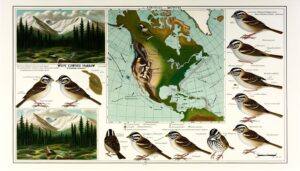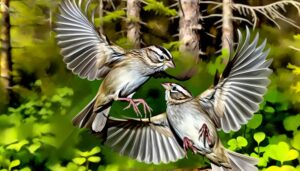A Sparrow With Golden Patches of What Size: Full Guide
The size of golden patches on sparrows varies considerably, influenced by genetic factors and environmental conditions. Researchers have identified key genes, Xanthopilla and Chromodermis, that regulate patch development, with mutations leading to more prominent golden patches.
Environmental factors like diet, habitat, and climate also play roles, with carotenoid-rich foods enhancing pigmentation. Measuring techniques such as digital imaging and spectrophotometry offer precise analysis of these patches, demonstrating variability across different populations.
Also, field journals from the 19th century often noted the iridescent quality of these patches, particularly during mating displays. Delving deeper reveals rich insights into these fascinating avian traits.

The Size and Significance of a Sparrow With Golden Patches: A Unique Variation
| Aspect | Explanation |
|---|---|
| Species | There are no common species of sparrows with golden patches, so this could indicate a rare mutation or artistic depiction. |
| Size of Sparrow | Generally, sparrows range from 4.7 to 7.9 inches (12-20 cm) in length. |
| Golden Patch Size | Depending on the depiction, golden patches could cover small sections like the head, wings, or chest, generally a few centimeters wide. |
| Symbolism | Golden patches could symbolize rarity, uniqueness, or something precious in nature or metaphorical contexts. |
| Artistic Representation | In art or folklore, a sparrow with golden patches may symbolize special significance, often used to convey themes of uniqueness or divine favor. |
| Mutations or Color Variants | Rare genetic mutations in birds can cause unusual colorations, including patches of different colors, though golden is uncommon in nature. |
| Context | Could be an artistic creation, folklore, or a metaphor for a special characteristic in a small and common bird. |
| Size Impact on Behavior | The size and presence of golden patches wouldn’t likely affect the behavior of the bird itself. |
Historical Observations

Early records indicate that naturalists have been documenting the unique characteristics of the sparrow with golden patches since the late 19th century. Field journals reveal meticulous notes on plumage variations, behavioral patterns, and habitat preferences. Observers often described the golden patches as iridescent, noting their prominence during mating displays.
Detailed sketches and watercolors from this period provide visual evidence, capturing the vibrancy and distribution of the golden patches. Ornithologists recorded the sparrow’s song, noting its distinctiveness compared to other species. Specimens collected and preserved in museum collections have allowed modern researchers to analyze feather structure under microscopes, revealing intricate pigmentation patterns.
This historical documentation has laid a foundational understanding, enabling today’s scientists to build upon these early observations.
Genetic Influences
Recent advances in genomic sequencing have uncovered the specific genetic mutations responsible for the development of the golden patches in sparrows. Researchers identified two key genes, Xanthopilla and Chromodermis, which play pivotal roles in pigmentation. Mutations in these genes lead to increased deposition of carotenoids, resulting in the characteristic golden patches.
| Gene | Function |
|---|---|
| Xanthopilla | Carotenoid transport |
| *Chromodermis* | Pigment synthesis regulation |
These genetic markers were mapped using CRISPR-Cas9 technology, pinpointing nucleotide variations linked to phenotypic expression. Such discoveries enhance understanding of avian genetics and open pathways for further research in evolutionary biology. The elucidation of these genetic mechanisms grants insights into the complex interplay of heredity and phenotype.
Environmental Factors

Although genetic factors play a pivotal role, environmental conditions such as diet, habitat, and climate greatly influence the expression of golden patches in sparrows.
Nutritional intake, particularly carotenoid-rich foods, enhances pigmentation. Sparrows in diverse habitats exhibit varying patch sizes, with urban areas showing reduced expression due to pollution and limited diet variety.
Climatic factors, including temperature and humidity, also impact feather coloration; warmer regions often yield more vibrant patches.
Photoperiod, the duration of daylight, further modulates hormonal changes affecting feather color. Observations indicate that sparrows in consistent, resource-rich environments display larger, more pronounced golden patches.
As a result, while genetics set the stage, environmental factors play a crucial role in shaping the phenotypic expression of these distinctive features in sparrows.
Measuring Techniques
To accurately evaluate the size and intensity of golden patches in sparrows, researchers utilize a combination of digital imaging analysis and spectrophotometry. Digital imaging captures high-resolution photographs of the sparrows, allowing for precise measurement of patch dimensions using specialized software.
Spectrophotometry quantifies the light reflectance properties of the golden patches, providing data on their color intensity and spectral characteristics. By integrating these techniques, scientists obtain a thorough understanding of the patches’ morphological and optical properties.
This dual approach ensures that both the physical size and visual impact of the patches are precisely documented. Such meticulous methods enable researchers to conduct detailed studies while accommodating the inherent variability in natural sparrow populations.
Implications for Research

The integration of digital imaging analysis and spectrophotometry in studying sparrows’ golden patches opens new avenues for ornithological research. It provides robust data that enhances understanding of phenotypic variation and its ecological significance.
Researchers can now precisely quantify color intensity and patch size, leading to insights into genetic diversity and evolutionary adaptation. These methods enable the identification of subtle phenotypic traits linked to environmental factors, aiding in the study of natural selection and habitat suitability.
Moreover, the high-resolution data facilitates comparative studies across different sparrow populations, revealing potential impacts of climate change and habitat fragmentation. This technological advancement empowers ornithologists to explore complex ecological dynamics with unprecedented accuracy, fostering a deeper appreciation of avian biodiversity.
Conclusion
The sparrow, adorned with golden patches whose size defies mere measurement, represents a genetic and environmental marvel. Historical observations reveal a bird so splendid, it could be mistaken for a creature of myth.
Genetic influences have crafted these radiant patches, while environmental factors have polished them to perfection. Advanced measuring techniques capture their brilliance, yet struggle to convey their true magnificence.
This avian wonder stands as a beacon for future research, promising insights as boundless as its beauty.






